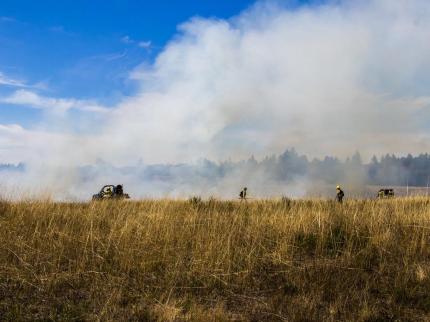ARCHIVED NEWS RELEASE
This document is provided for archival purposes only. Archived documents do not reflect current WDFW regulations or policy and may contain factual inaccuracies.
News release
Darric Lowery, 360-701-5145
Rachel Blomker, 360-701-3101
OLYMPIA — Starting Aug. 31, the Washington Department of Fish and Wildlife (WDFW) will conduct controlled burns for habitat restoration at the Scatter Creek Wildlife Area Unit northeast of Rochester, and the West Rocky Prairie Wildlife Area Unit northwest of Tenino.
Controlled burns will take place for up to five days between the end of August and mid-October, depending on the weather. The areas targeted for burns are small, varying in size from one to 10 acres.

“Portions of the wildlife areas may be closed during the burns, and people may see smoke from the fires for one to two hours after the burns,” said Darric Lowery, Scatter Creek Wildlife Area Manager for WDFW. “We will work to minimize smoke impacts to homes and the surrounding community.”
WDFW works cooperatively with the Washington Department of Natural Resources, fire districts, and other partners, utilizing professional fire crews experienced in conducting controlled burns on public and private lands in the region.
Lowery said the department uses controlled burns to maintain native grassland habitats, also known as prairies, and control invasive weeds before seeding and planting native species.
Coastal prairies are one of the rarest ecosystems in Washington, now reduced to less than 3% of their former area. They support a variety of rare plants and animals, including birds, mammals, and butterflies, some of which are listed as threatened or endangered species under the federal Endangered Species Act.
WDFW actively manages approximately 1 million acres of land and over 500 water access areas across the state to preserve natural and cultural heritage, provide access for hunting, fishing, and wildlife-related recreation, and to foster experiences and exploration for thousands of Washingtonians and visitors each year.
WDFW is the state agency tasked with preserving, protecting and perpetuating fish, wildlife and ecosystems, while providing sustainable fishing, hunting, and other recreation opportunities.